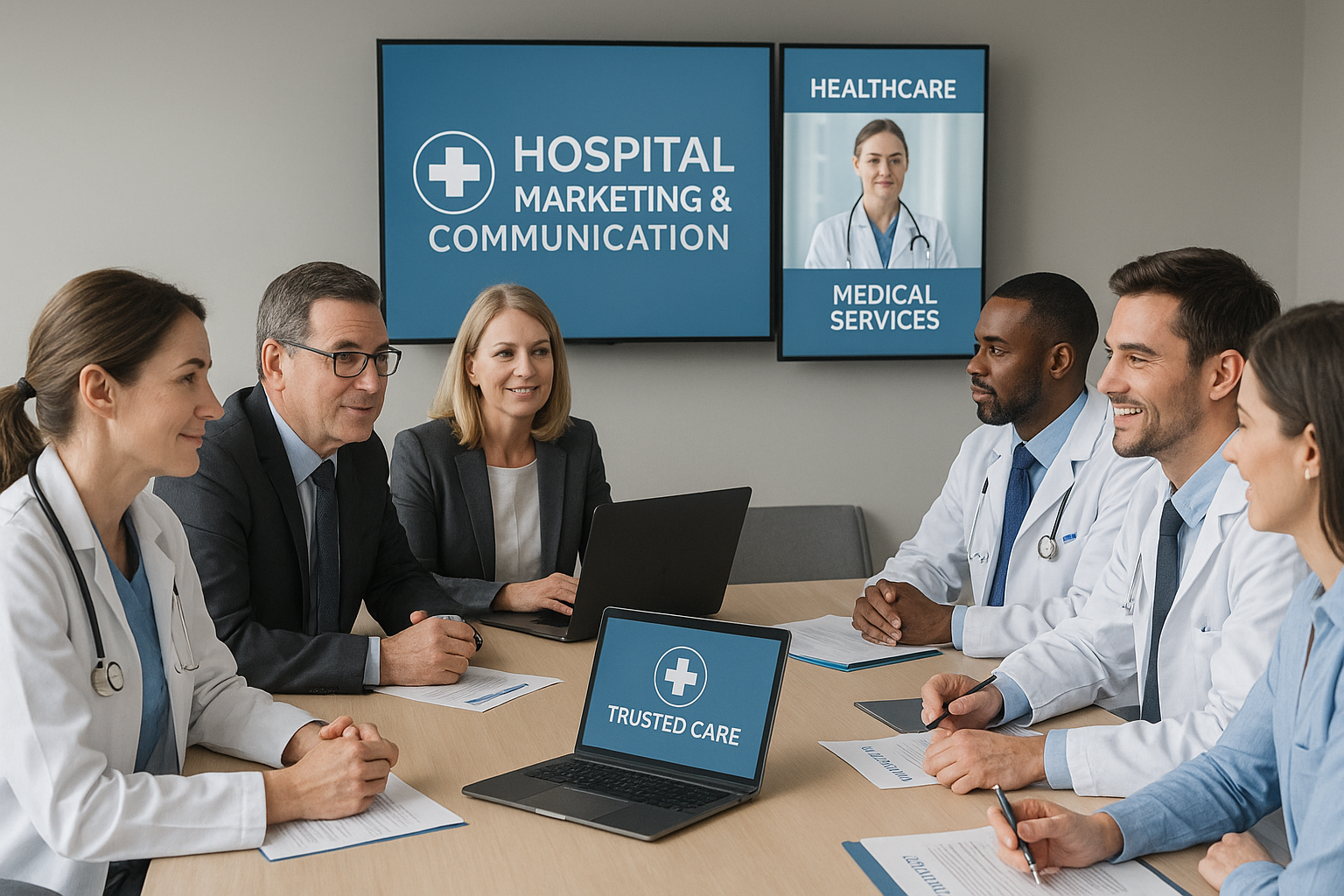A patient receives a concerning diagnosis. Their first instinct? Google. Within minutes, they’re overwhelmed by conflicting information—authoritative medical sites, questionable blogs, anecdotal forums, and sponsored content all competing for attention. Some sources terrify them unnecessarily. Others provide false reassurance. Most use terminology they don’t understand. They’re left more confused and anxious than before their search began. Now imagine a different scenario: That same patient finds comprehensive, clear, empathetic content from your healthcare organization—content that explains their condition in plain language, outlines treatment options honestly, provides realistic expectations, and offers ongoing support resources. They feel understood, informed, and confident in your expertise. When it’s time to choose a provider, who do you think they’ll call? This is the transformative power of healthcare content marketing.
Only 12% of adults in the United States demonstrate proficient health literacy, meaning 88% struggle to understand and use health information effectively. Yet 77% of people search for information during their patient journey, and 70% of people influenced by online health information change their treatment decisions. Healthcare organizations that fill this information gap with high-quality educational content don’t just market—they serve. They transform anxious searchers into informed patients, and informed patients into loyal advocates.
This comprehensive guide explores how strategic content marketing educates patients, builds lasting loyalty, and positions your organization as the trusted healthcare resource your community deserves.
Why Patient Education Drives Loyalty
Before diving into tactics, we must understand the fundamental connection between education and loyalty in healthcare. The Trust Equation in Healthcare Healthcare relationships are built on trust—perhaps more so than any other industry. Patients literally place their lives in providers’ hands. This trust doesn’t emerge from advertising slogans or promotional campaigns. It grows from consistent demonstration of expertise, empathy, and commitment to patient wellbeing. Educational content demonstrates all three.
When you invest resources in helping patients understand their health without expecting immediate return, you signal that you care about their wellbeing beyond transactions. When your content consistently provides accurate, helpful information, you prove your expertise. When your messaging empathizes with patient fears and concerns, you connect emotionally. Creating informative digital content should remain a key strategy for healthcare marketers. Educational resources help build trust and authority while addressing common health concerns. The Information Gap Creates Opportunity Health literacy statistics reveal a significant challenge across various populations, indicating that many individuals struggle to understand and use health-related information effectively. In Europe, nearly 50% of adults reported inadequate health literacy for managing their own health issues. This massive information gap represents enormous opportunity.
The healthcare organizations that successfully translate complex medical information into accessible, actionable knowledge become indispensable resources. Patients return repeatedly—not just for care, but for information, guidance, and reassurance. Educated Patients Are Better Patients Beyond loyalty benefits, patient education improves health outcomes—the ultimate goal of healthcare. Access to comprehensive and understandable health information allows patients to make informed decisions, follow treatment plans more effectively, and adopt healthier lifestyle choices. Heart failure patients who received education were 23% less likely to be readmitted to the hospital within a month than those who didn’t. Education doesn’t just drive loyalty—it saves lives and reduces costs.
Educated patients:
Adhere better to treatment plans
Ask more informed questions during appointments
Recognize warning signs requiring medical attention
Make healthier lifestyle choices
Experience less anxiety about their conditions
Become active participants in their care rather than passive recipients
Developing Your Healthcare Content Strategy Successful patient education through content marketing requires strategic planning, not haphazard content creation. Understanding Your Audience’s Information Needs By analyzing data from electronic health records (EHRs), wearable devices, and online interactions, organizations can understand patient preferences, behaviors, and health needs.
Audience Research Methods:
Search Data Analysis: What health questions are people in your community searching for? Tools like Google Search Console, AnswerThePublic, and SEMrush reveal exactly what patients want to know.
Patient Surveys: Ask patients directly what information they wish they had before, during, and after treatment. Their answers guide content priorities.
Clinical Staff Input: Physicians, nurses, and support staff hear the same questions repeatedly. Document these to create FAQ-based content addressing real patient concerns.
Social Listening: Monitor social media, health forums, and review sites to understand what patients discuss, worry about, and seek information on.
Analytics Review: Which existing content performs best? What topics drive engagement? Double down on what resonates.
Creating Patient Personas Not all patients have identical information needs. A study from Evergage indicated that 88% of marketers believe that personalized content is a key ingredient to their success.
Effective Healthcare Personas Include:
The Newly Diagnosed: Just received diagnosis, overwhelmed, seeking basic condition understanding.
Needs: Plain language explanations, treatment overview, what to expect, emotional support.
The Chronic Disease Manager: Living with ongoing condition, experienced but seeking optimization.
Needs: Advanced management tips, latest research, lifestyle integration strategies, community connection.
The Preventive Care Seeker: Healthy but proactive about wellness.
Needs: Screening guidelines, risk reduction strategies, wellness tips, healthy aging information.
The Caregiver: Supporting loved one with health challenges.
Needs: Caregiving resources, support information, respite care options, self-care guidance.
The Healthcare Skeptic: Distrustful of traditional medicine, seeks alternatives.
Needs: Evidence-based content, transparency, integration of complementary approaches where appropriate. Create content specifically addressing each persona’s unique needs, questions, and concerns. Establishing Content Pillars and Topics Organize your content strategy around 3-5 core themes or “pillars” that align with your organizational strengths and patient needs. Example Content Pillars for a Cardiology Practice: Heart Health Education: Condition explanations, risk factors, prevention Treatment Options: Procedures, medications, interventions explained
Lifestyle and Wellness: Diet, exercise, stress management for heart health
Patient Success Stories: Real experiences (with authorization)
Latest Research and Innovation: New treatments, clinical trials, advances
Under each pillar, develop specific topics addressing patient questions at various awareness and engagement levels. Content Formats That Educate Effectively Different formats serve different educational purposes. The most effective strategies leverage multiple formats reinforcing the same core messages. Blog Posts and Articles: The Foundation High-quality content drives both online traffic and patient loyalty. Offer eBooks, videos or infographics that break down complex procedures. Clear, in-depth guides increase confidence, encouraging readers to book an appointment or recommend your facility. Blog Content Best Practices: Answer Specific Questions: Each post should answer one clear question patients actually ask. Use question-based headlines: “What Causes High Blood Pressure?” “How Do I Prepare for Cataract Surgery?” Use Plain Language: Write at 6th-8th grade reading level. Define medical terms when necessary. Use analogies to explain complex concepts. Structure for Scannability: Use short paragraphs, subheadings, bullet points, and white space. Most readers scan before committing to reading fully. Provide Actionable Information: Don’t just explain problems—offer concrete next steps patients can take. Cite Credible Sources: Link to peer-reviewed research, professional medical organizations, and authoritative health institutions to build credibility. Update Regularly: Medical knowledge evolves. Review and update popular content annually to maintain accuracy and search rankings. Video Content: The Engagement Champion Video content continues to be a cornerstone of healthcare marketing strategies in 2025. Educational video series, patient testimonials, and live-streamed Q&A sessions engage audiences more effectively than static content. By 2025, it is expected that over 80% of all online content will be in video format. According to a 2022 survey by Charity RX, 1 in 5 Americans consult TikTok for health advice before contacting a physician. Effective Healthcare Video Types: Condition Explainers (2-3 minutes): Simple, visual explanations of health conditions, causes, symptoms, and treatment options. Example: “Understanding Type 2 Diabetes in 3 Minutes” Procedure Walkthroughs (3-5 minutes): Show what patients can expect during procedures, reducing anxiety through transparency. Example: “What to Expect During Your First Colonoscopy” Expert Q&As (5-10 minutes): Physicians answer common patient questions, building credibility while addressing concerns. Example: “Your Top 10 Questions About Heart Surgery Answered” Patient Success Stories (2-4 minutes): Real patients (with authorization) sharing their treatment experiences and outcomes. Authentic testimonials build trust more effectively than promotional content. Health Tips Series (60-90 seconds): Short, actionable tips patients can implement immediately. Perfect for social media. Example: “5 Ways to Lower Blood Pressure Naturally” Live Webinars: Webinars have surged in prominence, particularly in healthcare, serving as an invaluable channel for disseminating information, establishing expertise, and fostering community. Downloadable Resources: Value-Rich Assets Comprehensive guides, checklists, and workbooks that patients can download and reference repeatedly demonstrate substantial value. High-Value Downloadable Content: Comprehensive Condition Guides: 10-20 page PDFs covering everything about specific conditions—causes, symptoms, diagnosis, treatment, living with the condition, resources. Preparation Checklists: What to do before procedures, appointments, surgeries. Reduces patient anxiety and improves outcomes. Medication Guides: Easy-to-understand information about medications—how they work, side effects, what to do if dose is missed, drug interactions. Symptom Trackers: Printable logs for tracking symptoms, medications, blood pressure, glucose, pain levels, mood, etc. Nutrition and Exercise Plans: Condition-specific diet and activity guidance patients can follow independently. Interactive Tools: Engagement Through Participation Interactive content creates engagement through active participation rather than passive consumption. Interactive Healthcare Tools: Symptom Checkers: Help patients understand whether symptoms warrant immediate care, urgent appointment, or monitoring. (Include disclaimers that tools don’t replace professional medical advice.) Health Risk Assessments: Questionnaires evaluating personal risk for conditions like heart disease, diabetes, or cancer based on family history, lifestyle, and other factors. Cost Estimators: Help patients understand potential costs for procedures or treatments, improving transparency and reducing surprise billing anxiety. BMI and Health Calculators: Simple tools calculating BMI, ideal body weight, caloric needs, medication dosages (for informational purposes). Decision Aids: Interactive tools helping patients weigh treatment options based on personal values and priorities. Email Newsletters: Consistent Touchpoints 88% of patients expect healthcare organizations to use email as a communication channel. The average open rate for emails related to medical, dental, and healthcare is 44.60%—significantly higher than most industries. Email Newsletter Best Practices: Segment Your Audience: Send different content to different patient groups based on conditions, demographics, engagement level, and information needs. Maintain Consistent Schedule: Monthly or bi-monthly newsletters keep your organization top-of-mind without overwhelming subscribers. Mix Content Types: Include links to blog posts, videos, upcoming webinars, health tips, practice news, and community resources. Personalize When Possible: Use patient data (where HIPAA-compliant) to personalize content recommendations, appointment reminders, and health tips. Include Clear Calls-to-Action: While primarily educational, include pathways to schedule appointments, access patient portal, or contact your practice. Distribution: Getting Content to Patients Creating great content means nothing if patients never see it. Strategic distribution amplifies reach and impact. Owned Media Optimization Website as Content Hub: Your website should be the central repository for all educational content, organized intuitively by condition, treatment, specialty, and topic. Patient Portal Integration: Deliver relevant content via email marketing campaigns or patient portals. Send targeted, personalized email campaigns to patients with educational content, appointment reminders, promotional offers. Mobile App: For organizations with dedicated apps, push notifications can alert patients to relevant new content based on their health profiles and interests. Earned Media and Partnerships Media Relations: Position physicians as expert sources for local news coverage of health topics. Media appearances drive traffic to your content. Guest Blogging: Contribute expert content to reputable health websites, publications, and community platforms with links back to your comprehensive resources. Professional Partnerships: Partner with employers, schools, community organizations, and other healthcare providers to share educational content with their audiences. Patient Advocacy Groups: Collaborate with disease-specific advocacy organizations to co-create and distribute content serving shared patient populations. Social Media Distribution Social media platforms offer an unparalleled opportunity for healthcare marketers to connect with patients on a more personal level. Platform-Specific Strategies: Facebook: Share blog posts, videos, health tips, and event announcements. Encourage discussion through questions and community engagement. Instagram: Visual health education through infographics, short videos, patient stories (with consent), and behind-the-scenes content humanizing your organization. LinkedIn: Professional content targeting referring physicians, healthcare professionals, and B2B audiences. YouTube: Host your video content library with playlists organized by topic, making it easy for patients to find relevant information. TikTok: Short-form educational content, myth-busting, health tips, and trending health topics reaching younger demographics. Paid Distribution for Strategic Amplification While organic reach is ideal, paid promotion accelerates content discovery and ensures critical information reaches target audiences. Paid Promotion Strategies: Search Engine Marketing: Promote key content for high-value search terms related to conditions you treat and services you offer. Social Media Ads: Target specific demographics with relevant educational content—diabetes resources to at-risk populations, cardiac health to older adults. Retargeting: Show educational content to people who’ve visited your website, keeping your organization top-of-mind as they research. Native Advertising: Promote content through platforms like Outbrain, Taboola, or Healthline Media reaching health-conscious audiences. Measuring Content Marketing Success Data drives better ROI: Analytics and KPIs help optimize spend and improve patient acquisition. Tracking the right metrics proves content value and identifies improvement opportunities. Engagement Metrics Content Performance: Page views and unique visitors Time on page and scroll depth Video completion rates Download rates for gated content Social shares and engagement Comments and questions These metrics indicate whether content resonates with audiences and provides value they’re willing to engage with deeply. Conversion Metrics Patient Actions: Appointment requests following content consumption Patient portal registrations Newsletter subscriptions Contact form submissions Phone calls attributed to content New patient conversion rates These metrics connect content directly to business outcomes, demonstrating ROI. Loyalty and Retention Metrics Long-Term Relationship Indicators: Return visitor rates Patient retention percentages Net Promoter Score (NPS) Patient satisfaction scores Referral rates from existing patients Patient lifetime value Engaging content, such as personalized health tips, interactive tools, and patient success stories, fosters a deeper connection between patients and healthcare providers. This connection is crucial for increasing patient retention and generating positive word-of-mouth referrals. A well-executed healthcare content strategy can significantly enhance patient loyalty. SEO and Discovery Metrics Organic Visibility: Search engine rankings for target keywords Organic traffic growth over time Domain authority improvements Backlinks from authoritative health sites Featured snippet appearances Over half of online sessions start with a search query, many seeking healthcare information. Successful SEO balances accuracy with readability. Real-World Success: Content Marketing That Works Theory matters, but demonstrated results prove the business case for content marketing investment. Mayo Clinic: The Content Authority Mayo Clinic has built one of the most respected healthcare content libraries in the world. Their comprehensive disease and condition guides, health living content, and expert perspectives establish them as the authoritative health information source. Their content strategy drives millions of monthly visits to mayoclinic.org, building brand recognition far beyond their geographic service area and positioning them as patients’ first choice when seeking specialized care for complex conditions. Cleveland Clinic: Personalized Content Delivery Cleveland Clinic’s use of predictive analytics to tailor email campaigns has led to higher email open rates and improved patient engagement. By analyzing past behaviors, they create content specific to patients’ interests, such as heart health or joint pain management. This data-driven personalization ensures patients receive relevant information when they need it most, strengthening relationships and driving loyalty. Big Sea Healthcare Client: $6,000 from One Email Big Sea helped one of their healthcare clients generate over $6,000 with a single email newsletter, proving that strategic content distribution drives direct revenue while providing educational value. Best Practices for Healthcare Content Excellence Certain principles separate exceptional healthcare content from mediocre efforts. Medical Accuracy and Credibility Non-Negotiable Standards: All clinical content reviewed by qualified healthcare professionals Citations to peer-reviewed research and authoritative medical sources Author credentials clearly displayed Last-updated dates shown prominently Disclaimers that content doesn’t replace professional medical advice Adherence to Google’s E-E-A-T principles (Experience, Expertise, Authoritativeness, Trustworthiness) Ensure your Google Business Profile is verified with correct details and business hours. Google’s E-E-A-T (Expertise, Experience, Authority and Trust) framework emphasizes detailed medical pages. Accessibility and Inclusivity Content must be accessible to all patients regardless of ability, language, or health literacy level. Accessibility Requirements: WCAG 2.1 AA compliance for digital accessibility Alt text for all images Closed captions for all videos Transcripts for audio content Readable fonts and sufficient color contrast Screen reader compatibility Inclusivity Practices: Content available in multiple languages for multilingual communities Diverse representation in images and patient stories Cultural sensitivity in health messaging Content addressing health disparities and social determinants of health HIPAA Compliance in Content Creation Patient privacy must be protected even in educational and marketing content. HIPAA-Compliant Content Practices: Never use protected health information without explicit written authorization De-identify all patient examples to prevent identification Obtain specific consent for testimonials, photos, and videos documenting exact usage Secure storage and transmission of any patient data used in content creation Staff training on HIPAA requirements for content creators Continuous Improvement Through Testing The best content strategies evolve based on performance data and patient feedback. Optimization Practices: A/B test headlines, formats, and calls-to-action Regularly review analytics to identify top-performing content Survey patients about content usefulness and information gaps Update evergreen content based on new research and guidelines Experiment with new formats and distribution channels Monitor competitor content strategies and differentiate The Future of Healthcare Content Marketing Several emerging trends will shape how healthcare organizations educate and engage patients. AI-Powered Personalization at Scale The use of AI would not be restricted to chatbots and automated support only; hospitals will be using AI to personalize website content, prompt appointments, and send follow-up communications based on a patient’s medical history, behavior, and preference. AI will enable unprecedented personalization, showing each patient content most relevant to their specific health profile, concerns, and preferences—while maintaining privacy and compliance. Voice and Conversational Content As voice assistants become primary information sources, healthcare content must optimize for natural language queries and conversational delivery. Virtual and Augmented Reality AR apps that allow users to see how medications interact with the body provide a compelling way to educate and reassure patients about treatments. VR and AR will create immersive educational experiences impossible with traditional content formats. Community-Generated Content Patient communities sharing their experiences, tips, and support (with proper moderation and oversight) will complement professional content, providing peer perspectives that resonate differently than institutional messaging.
Conclusion: Education as the Ultimate Loyalty Strategy In an era of healthcare consumerism, where patients have choices and exercise them freely, loyalty emerges not from proximity or insurance networks but from relationships. And relationships in healthcare, as in life, are built on trust. Content marketing that genuinely educates—that anticipates questions, alleviates anxieties, demystifies complexity, and empowers patients—builds that essential trust more effectively than any advertising campaign ever could. Creating informative digital content should remain a key strategy for healthcare marketers. Educational resources help build trust and authority while addressing common health concerns. But beyond trust and authority, great healthcare content does something even more valuable: it genuinely helps people.
When your content helps someone understand a confusing diagnosis, guides them through a frightening procedure, empowers them to make an informed treatment decision, or simply provides reassurance during a difficult time—you’ve done more than marketing. You’ve provided care. And patients remember, appreciate, and remain loyal to organizations that care for them even before they become patients. The healthcare organizations that will thrive in coming years are those that recognize content marketing isn’t about driving traffic or generating leads—though it accomplishes both. It’s about serving patients wherever they are in their health journey, providing value without immediate expectation of return, and demonstrating through consistent action that patient wellbeing transcends business interests. Your expertise can help thousands through educational content.
Your empathy can comfort anxious patients searching for answers. Your commitment to transparency can build trust that lasts a lifetime. Content marketing makes all of this possible, one educated, empowered, loyal patient at a time. Ready to develop a content marketing strategy that educates patients and builds lasting loyalty? Our team specializes in healthcare content marketing, combining medical expertise with strategic marketing to create content that truly serves patients while driving business results. From strategy development and content creation to distribution and measurement, we help healthcare organizations become the trusted information sources their communities need. Contact us today for a complimentary content audit.
References
- Cardinal Digital Marketing. (2024). “8 Video Marketing Trends for Healthcare in 2025.” Retrieved from https://www.cardinaldigitalmarketing.com/healthcare-resources/blog/5-video-marketing-trends-for-healthcare-in-2025/
- Healthcare Success. (2024). “11 Healthcare Marketing Predictions for 2025.” Retrieved from https://healthcaresuccess.com/blog/healthcare-marketing/11-healthcare-marketing-predictions-for-2025.html
- Brands at Play. (2025). “Healthcare Content Marketing Guide: 2025 Patient Engagement Trends.” Retrieved from https://blog.brandsatplayllc.com/blog/healthcare-content-marketing-guide-2025-patient-engagement-trends
- Big Sea. (2025). “Top Healthcare Digital Marketing Trends in 2025.” Retrieved from https://bigsea.co/ideas/healthcare-digital-marketing/
- Viseven. (2025). “Healthcare Marketing Trends: What to Expect in 2025.” Retrieved from https://viseven.com/healthcare-marketing-trends/
- Keragon. (2025). “9 Latest Healthcare Marketing Trends (Updated for 2025).” Retrieved from https://www.keragon.com/blog/healthcare-marketing-trends
- Big Drop. (2024). “The Future of Healthcare Marketing: 2025 Trends to Watch.” Retrieved from https://www.bigdropinc.com/blog/the-future-of-healthcare-marketing-2025-trends-to-watch/
- Digital Silk. (2025). “15 Healthcare Marketing Strategies For 2025 ROI.” Retrieved from https://www.digitalsilk.com/digital-trends/healthcare-marketing-strategies/
- Intrepy. (2025). “What Is the Best Healthcare Marketing Strategy in 2025?” Retrieved from https://intrepy.com/importance-healthcare-marketing/
- Content Whale. (2025). “Content Marketing for Healthcare: Strategies and Examples.” Retrieved from https://content-whale.com/blog/content-marketing-for-healthcare/
- NinjaPromo. (2025). “Healthcare Digital Marketing: Best Strategies for Medical Companies.” Retrieved from https://ninjapromo.io/the-complete-guide-to-digital-marketing-for-healthcare
- Exposure Ninja. (2025). “Digital Marketing Strategy for Healthcare: 2026 Guide.” Retrieved from https://exposureninja.com/blog/digital-marketing-strategy-for-healthcare/




